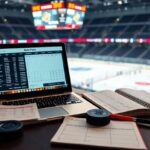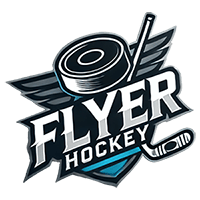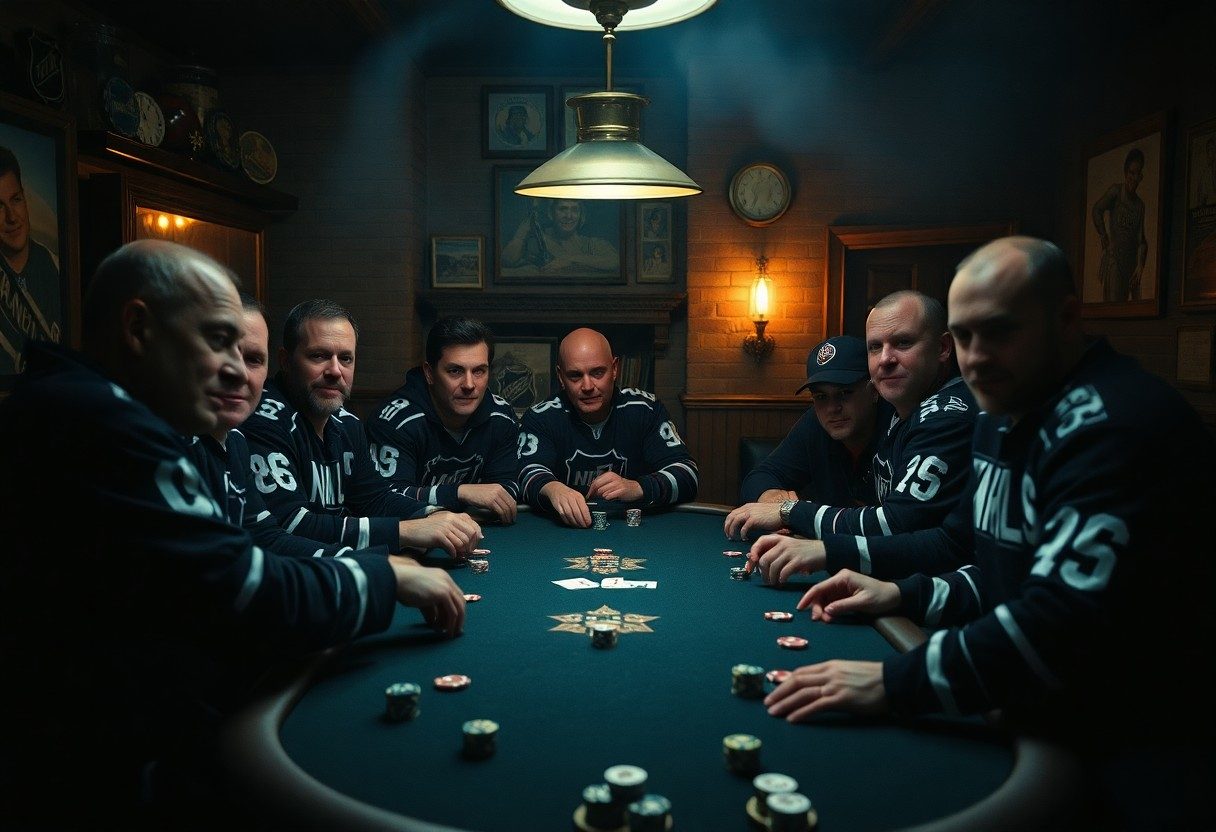Offseason training is vital for NHL players to maintain peak performance and prevent injury as they prepare for the upcoming season. This period is dedicated to a mix of strength conditioning, skill development, and endurance training, ensuring players enhance their physical attributes and fine-tune their game skills. Many also focus on mental conditioning, incorporating techniques to boost focus and resilience. By committing to this intensive training regimen, players not only stay fit but also gain a competitive edge, making offseason preparation a vital component of their professional success.
Types of Off-Season Training
- Strength and Conditioning
- On-Ice Skills Development
- Cardiovascular Training
- Nutrition
- Mental Training
| Training Type | Description |
|---|---|
| Strength and Conditioning | Focuses on building muscle and improving physical endurance. |
| On-Ice Skills Development | Emphasizes enhancing skating, shooting, and puck handling. |
| Cardiovascular Training | Boosts overall stamina and cardiovascular health. |
| Nutrition | Aims to optimize energy levels and recovery through diet. |
| Mental Training | Develops focus, resilience, and game strategy. |
Strength and Conditioning
Strength and conditioning regimens are vital during the off-season, utilizing a mix of weight training, resistance exercises, and functional movement drills. These workouts help players increase their muscular strength and explosiveness, translating directly to improved performance on the ice. This type of training often involves strategies such as Olympic lifts and agility drills, which challenge the body while minimizing injury risks.
On-Ice Skills Development
Off-season focuses on on-ice skills development to refine skating techniques, shooting accuracy, and puck control. Players often schedule multiple sessions per week with specialized coaches. This training ensures players work on their weak areas, and the repetition helps engrain positive habits, enhancing overall game readiness.
During these sessions, players engage in targeted drills that simulate game situations, allowing them to practice decision-making and execution under pressure. Skills like quick stick handling and accurate shots are honed to ensure athletes can respond effectively during intense match situations, leading to heightened performance when the season begins.
Cardiovascular Training
For NHL players, cardiovascular training is crucial for enhancing endurance and stamina. Off-season programs typically include long-distance running, interval sprints, and cycling, designed to elevate heart rates and improve aerobic capacity. This element of training is critical as hockey requires bursts of speed followed by recovery, necessitating superior cardiovascular fitness.
Maintaining cardiovascular health not only helps players during games but also aids in quicker recovery times from intense physical exertion. Training sessions often incorporate varied intensity levels, combining low and high intervals to mimic the demands of a game. This varied approach helps strengthen the heart and increases lung capacity, enabling players to perform at high levels throughout the season.
Tips for Effective Off-Season Training
- Set clear goals to guide your training.
- Create a balanced routine to address all physical aspects.
- Incorporate recovery strategies to maintain peak performance.
- Stay motivated through consistency and accountability.
Perceiving these tips as building blocks can significantly enhance an athlete’s off-season training effectiveness.
Setting Goals
Clear and measurable goals are imperative in off-season training. They provide direction and motivation, whether aiming to increase strength, improve endurance, or master particular skills. Players often utilize the SMART criteria (Specific, Measurable, Achievable, Relevant, Time-bound) to structure their targets effectively.
Creating a Balanced Routine
A well-rounded routine integrates strength training, agility drills, cardiovascular fitness, and skill work. By diversifying workouts, athletes prevent overuse injuries and ensure all muscle groups are developed. This holistic approach allows for optimal performance gains when the season starts.
Incorporating activities like weightlifting, sprint training, and specific hockey skill sessions contributes to overall athleticism. For example, a structured weekly plan might include three days dedicated to strength training, two days of endurance work, and one day focused on on-ice skills. Recognizing the need for variety is imperative; switching up exercises maintains engagement while addressing weaknesses.
Incorporating Recovery Strategies
Effective recovery strategies are integral to an off-season program. Strategies such as active recovery, proper hydration, and nutrition play vital roles in rebuilding and strengthening muscles. Additionally, techniques like foam rolling and stretching can alleviate soreness and enhance flexibility.
Prioritizing recovery enables athletes to train harder and more consistently. For instance, incorporating rest days every week or alternating intense workouts with lighter sessions equips the body to adapt and grow stronger. Integrating sleep hygiene practices also contributes significantly, with research indicating that adequate rest improves physical recovery and cognitive function.
Step-by-Step Training Plan
| Phase | Description |
|---|---|
| Assessment | Evaluate strengths and weaknesses using physical tests. |
| Strength Training | Focus on building muscle and power. |
| Skill Work | Develop specific hockey skills on the ice. |
| Endurance Training | Enhance cardiovascular fitness through various drills. |
| Recovery | Implement rest and nutrition for optimal recovery. |
Pre-Training Assessment
A pre-training assessment is necessary to identify baseline fitness levels and pinpoint areas needing improvement. Typically involving physical tests like the vertical jump, agility drills, and aerobic capacity tests, this step helps create a personalized training plan. By quantifying strengths and weaknesses, players can focus their training efforts effectively, ensuring a targeted and efficient off-season program.
Weekly Training Schedule
The weekly training schedule should include a mix of strength, agility, skill development, and recovery sessions. Players might target different muscle groups on alternating days while incorporating on-ice practice sessions for skill enhancement. For instance, a typical week could consist of three strength training days, two days of off-ice drills, and a rest day to maximize recovery.
This structured approach allows players to progress steadily while avoiding burnout. Including specific goals for each session—such as increasing weight lifted or improving shoot accuracy—ensures that training remains focused and effective. Regularly mixing up exercises and drills keeps the routine engaging and helps develop a comprehensive skill set.
Tracking Progress
Tracking progress is vital for maintaining motivation and adjusting training plans as needed. Players should keep detailed logs of their workouts, noting weights lifted, repetitions, and skill improvements. Utilizing performance metrics, such as sprint times or shooting accuracy percentages, provides quantifiable data that illustrates growth over time.
Monitoring this information not only reveals areas of success, but also highlights where adjustments may be necessary. By regularly reviewing these metrics, players can incorporate new goals, ensuring continuous improvement throughout the off-season. Analytics tools or apps can enhance this process, making it easier to visualize progress and stay accountable to training commitments.
Factors Influencing Training Methods
The training methods employed by NHL players are shaped by multiple factors that include individual needs, position, injury history, and personal preferences. These elements dictate the structure, intensity, and focus of their off-season programs, ultimately contributing to each player’s overall performance on the ice. Recognizing these influences allows for tailored training regimens for optimal results.
Player Position
Each player’s position in hockey requires specific training adaptations to enhance performance. For example, forwards may focus on agility and speed drills, while defensemen prioritize strength and endurance. Goalies, especially, incorporate unique elements like reflex training to maintain their edge in net. A position-specific approach is crucial in optimizing the effectiveness of their training.
Injury History
Injury history significantly impacts training methodologies, as players must implement tailored strategies to prevent re-injury. Assessing past injuries helps shape rehabilitation protocols, ensuring that the player can engage in rigorous workouts while being mindful of limitations. Addressing previous injuries with an informed approach can prevent further setbacks in performance.
For instance, if a player has a history of knee injuries, their off-season training may incorporate low-impact workouts, flexibility exercises, and strength training focused on lower body stability. This modified approach supports rehabilitation while enabling them to maintain their fitness levels. Additionally, working with medical professionals ensures that any training adaptation aligns with recovery goals, further promoting longevity in their careers.
Personal Preferences
Every player has unique personal preferences that influence their training routines. Some may thrive in high-intensity group environments, while others prefer solitary sessions focused on individual skill development. Recognizing personal preferences allows players to engage in programs that maximize motivation and enjoyment, which can lead to improved overall performance.
For example, players who enjoy competitive scenarios might favor training with teammates or participating in scrimmages during the off-season, while others may choose activities like yoga or Pilates for core strength and flexibility. Tailoring training to these preferences not only enhances engagement but also leads to better outcomes in physical fitness and skill refinement.
Pros and Cons of Different Training Approaches
| Pros | Cons |
|---|---|
| Increases cardiovascular fitness and endurance | Can lead to fatigue if overdone |
| Enhances muscle strength and performance | Adaptation may plateau without variation |
| Improves agility and skill through specific practice | Risk of injury from repetitive motions |
| Offers flexibility in training intensity levels | Requires specialized knowledge for effectiveness |
| Can be tailored to individual player needs | May lack overall conditioning focus |
| Time-efficient and can fit varied schedules | Not always accessible without professional guidance |
| Boosts metabolic rate for fat loss | Requires careful monitoring of recovery |
| Adaptable to different training environments | May not replicate game-like intensity |
| Encourages a diverse skill set | Potentially overwhelming for beginners |
| Promotes teamwork and camaraderie in drills | May lead to complacency in individual skill sets |
High-Intensity Interval Training (HIIT)
HIIT is an effective method for NHL players, allowing them to maximize their athletic output in a limited time. This approach combines short bursts of intense activity with periods of rest or lower-intensity exercise, enhancing both aerobic and anaerobic fitness. As a result, players develop endurance and agility, vital for sustaining performance throughout long games.
Traditional Strength Training
Traditional strength training involves structured workouts focusing on resistance exercises to build muscle mass, strength, and power. This approach is vital for NHL players, as increased muscle strength contributes directly to better performance, injury prevention, and overall durability during the season.
Players often engage in compound movements like squats, deadlifts, and bench presses, targeting multiple muscle groups at once. Periodizing these workouts throughout the off-season helps in enhancing specific attributes like explosiveness and overall functional strength. Combining traditional lifting with sport-specific training ensures a well-rounded approach to maintaining peak performance, while dumbbells and resistance bands can provide necessary versatility in exercises.
Sport-Specific Drills
Sport-specific drills are designed to replicate the actions and skills required during games. These drills may include skating techniques, puck handling, and shooting practice, crucial for refining skills in a targeted manner. Focusing on specific skills enhances on-ice performance and builds muscle memory vital for game situations.
By integrating sport-specific drills into their training, players can directly translate their practice into improved game performance. For instance, practicing quick stops and starts mimics the dynamic movements required during a match, ensuring players not only train their bodies but also sharpen their instincts and decision-making skills in realistic settings.
Nutrition and Recovery
NHL players prioritize nutrition and recovery to maintain peak performance throughout the grueling season. A well-rounded approach to diet, hydration, and sleep ensures athletes are energized, resilient, and prepared for the physical demands of the game.
Importance of Diet
Nutrition plays a vital role in an athlete’s performance. A balanced diet rich in lean proteins, healthy fats, and complex carbohydrates helps players build muscle, recover from workouts, and fuel their bodies for intense games. Many players work with nutritionists to tailor meal plans that support their individual needs and personalize their intake based on activity levels.
Hydration Strategies
Hydration is vital for optimal performance and recovery. NHL players often consume electrolyte-rich beverages and water before, during, and after training sessions to prevent dehydration, which can hinder strength and stamina.
To enhance hydration, players often utilize specific strategies such as weighing themselves before and after workouts to assess fluid loss, followed by replenishing with a combination of water and electrolyte drinks. Products containing sodium, potassium, and magnesium help retain fluids and prevent cramping, making timely hydration vital for sustained performance during practices and games.
Sleep and Recovery Techniques
Quality sleep is non-negotiable for recovery in NHL players. They aim for 7-9 hours of sleep nightly to allow for muscle repair and cognitive function improvement, which are critical during both training and competition.
Many players integrate techniques like maintaining a consistent sleep schedule, creating a dark and cool sleeping environment, and utilizing napping strategically to recover between workouts. Incorporating practices such as meditation and stretching before bedtime further enhances restful sleep, allowing players to optimize their recovery and physical readiness for training and games ahead.
Conclusion
The off-season training regimens of NHL players are vital for maintaining peak performance and extending their careers. By incorporating a combination of strength training, conditioning, skill development, and recovery strategies, athletes ensure they remain competitive when the season starts. This dedication to off-ice preparation highlights the importance of a well-rounded approach to fitness and hockey skill refinement, allowing players to adapt to the ever-evolving demands of the game.
FAQ
Q: What types of workouts do NHL players focus on during the off-season?
A: NHL players typically engage in a combination of strength training, cardiovascular conditioning, and on-ice skill development. Strength training includes weightlifting and resistance exercises to build power. Cardiovascular conditioning often involves running, cycling, or swimming to improve endurance. On-ice training focuses on skating techniques, puck handling, and shooting drills to maintain and enhance game skills.
Q: How do NHL players manage their nutrition during the off-season?
A: Players pay close attention to their nutrition by following a balanced diet rich in lean proteins, healthy fats, and carbohydrates. They often work with nutritionists to develop meal plans that support their training goals, including muscle recovery and energy levels. Staying hydrated and timing meals around workouts is also an imperative part of their off-season regimen.
Q: What mental training do NHL players undergo during the off-season?
A: Mental training is a key component, with players participating in visualization techniques, mindfulness exercises, and sports psychology sessions. These practices help them improve focus, develop resilience, and manage pressure. Many incorporate video analysis to review performance and understand strategies, which keeps their game IQ sharp even while away from regular season play.












